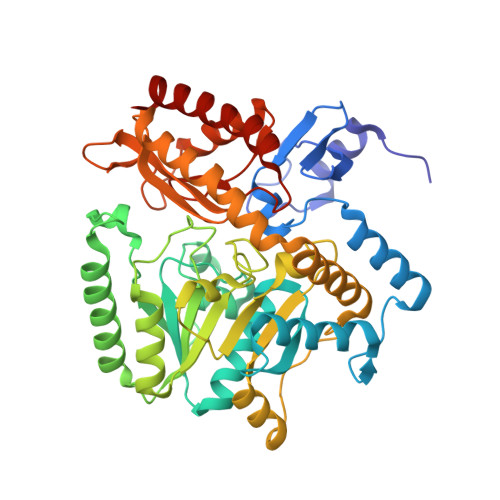Biochemical and structural investigation of taurine:2-oxoglutarate aminotransferase fromBifidobacterium kashiwanohense.
Li, M., Wei, Y., Yin, J., Lin, L., Zhou, Y., Hua, G., Cao, P., Ang, E.L., Zhao, H., Yuchi, Z., Zhang, Y.(2019) Biochem J 476: 1605-1619
- PubMed: 31088892
- DOI: https://doi.org/10.1042/BCJ20190206
- Primary Citation of Related Structures:
6JIX - PubMed Abstract:
Taurine aminotransferases catalyze the first step in taurine catabolism in many taurine-degrading bacteria and play an important role in bacterial taurine metabolism in the mammalian gut. Here, we report the biochemical and structural characterization of a new taurine:2-oxoglutarate aminotransferase from the human gut bacterium Bifidobacterium kashiwanohense ( Bk Toa). Biochemical assays revealed high specificity of Bk Toa for 2-oxoglutarate as the amine acceptor. The crystal structure of Bk Toa in complex with pyridoxal 5'-phosphate (PLP) and glutamate was determined at 2.7 Å resolution. The enzyme forms a homodimer, with each monomer exhibiting a typical type I PLP-enzyme fold and conserved PLP-coordinating residues interacting with the PLP molecule. Two glutamate molecules are bound in sites near the predicted active site and they may occupy a path for substrate entry and product release. Molecular docking reveals a role for active site residues Trp21 and Arg156, conserved in Toa enzymes studied to date, in interacting with the sulfonate group of taurine. Bioinformatics analysis shows that the close homologs of Bk Toa are also present in other anaerobic gut bacteria.
Organizational Affiliation:
Tianjin Key Laboratory for Modern Drug Delivery & High-Efficiency, Collaborative Innovation Center of Chemical Science and Engineering, School of Pharmaceutical Science and Technology, Tianjin University, Tianjin 300072, China.
















